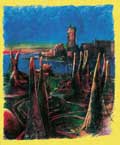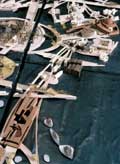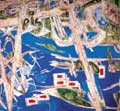Michael Sorkin Studio
| Michael Sorkin (*1948) | Andrei Vovk (*1958)
Hallowe'en
reminded me of Michael Sorkin
Two kids came to our door trick or treating, stepped into our house and
looked around. One kid asked me why we had a christmas tree. Before I
could reply the other kid said, "it's not a christmas tree, it's
a Hallowe'en tree. You have to use your imagination." Hallowe'en
is a time filled with expectations of simultaneous fear and fantasy. A
time when one's consciousness of the ironic nature of life's
events, places, people, and things serves to inspire the mind to great
leaps of imagination. "Ordinary" people reinvent themselves into extraodinary
representations of far-fetched things from static-cling to the Daughters
of the American Revolution. Anything and everything is subject to reinterpretation,
transformation, and reconfiguration. A twenty-four hour blast of freedom
to invent without fear end reproach. Magically, the darkest and brightest
sides of human endeavor and thought are brought into a universally acceptable
condition of equilibrium. Horror equals joy, death lives, pumpkins smile,
and skeletons dance. Michael Sorkin's view of the world might be
described as a Hallowe'enistic reality chek. He sees things exactly
as they are. He makes and describes things with an yelsing honesty. He
concerns himself with serious matters of the future of our world environment
and social and political order. His proposals are at once full of irony
and a delightful sense of humor. His solutions require horrifyingly difficult
yet strikingly simplistic action. He operates with a mind-set more inclined
toward the goofy world of Popular Mechanics than Ruskin's Seven Lamps
of Architecture. Architects of lesser skill, talent, and knowledge with
similar tendencies would undoubtedly slip into the less relevant world
of the idiosyncratic. Michael Sorkin, however, continues to impress with
his uncanny ability to strike fear in the hearts of the intelligentsia
and fantasy in the minds of the banal.
Mack Scogin












